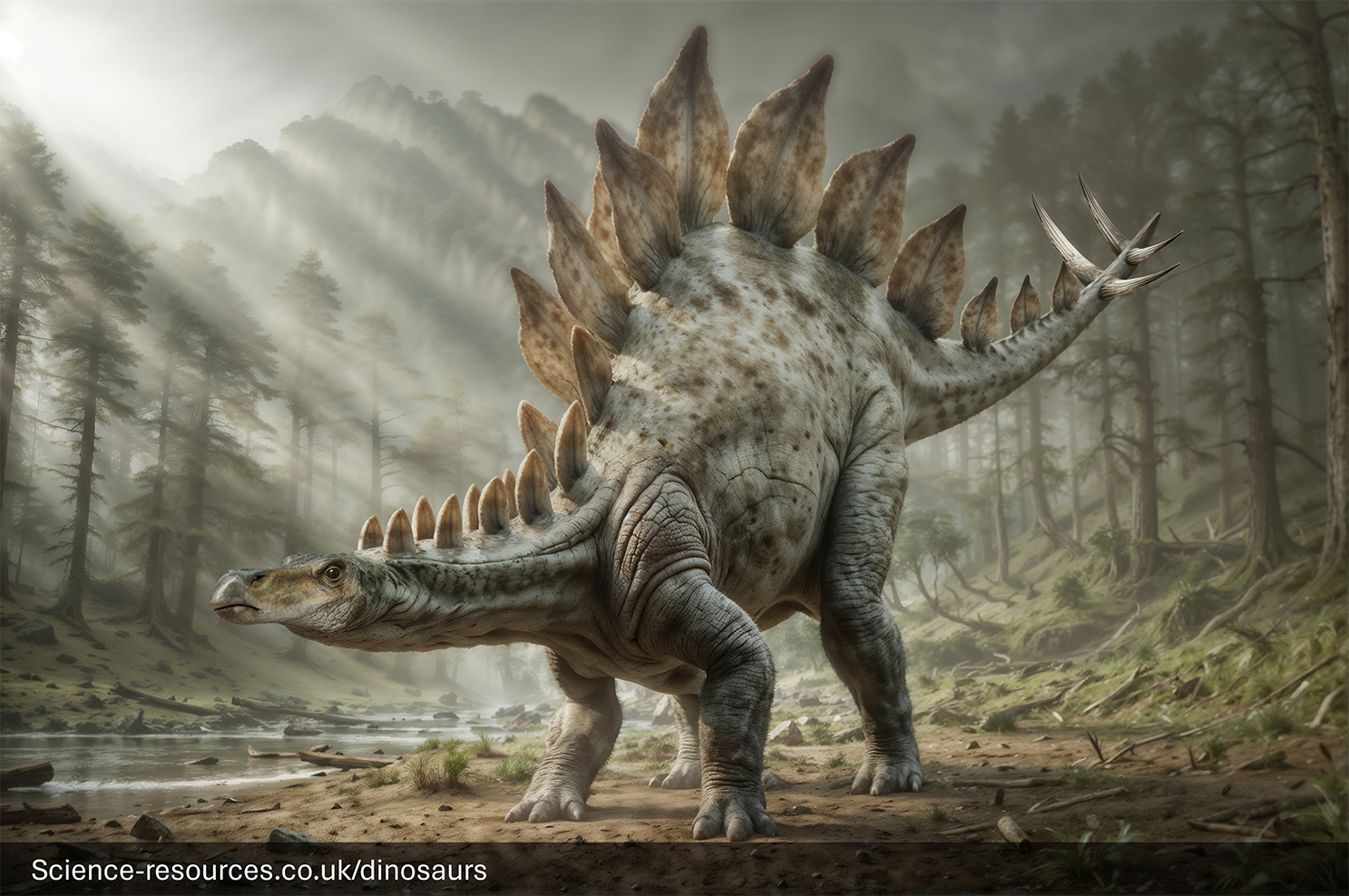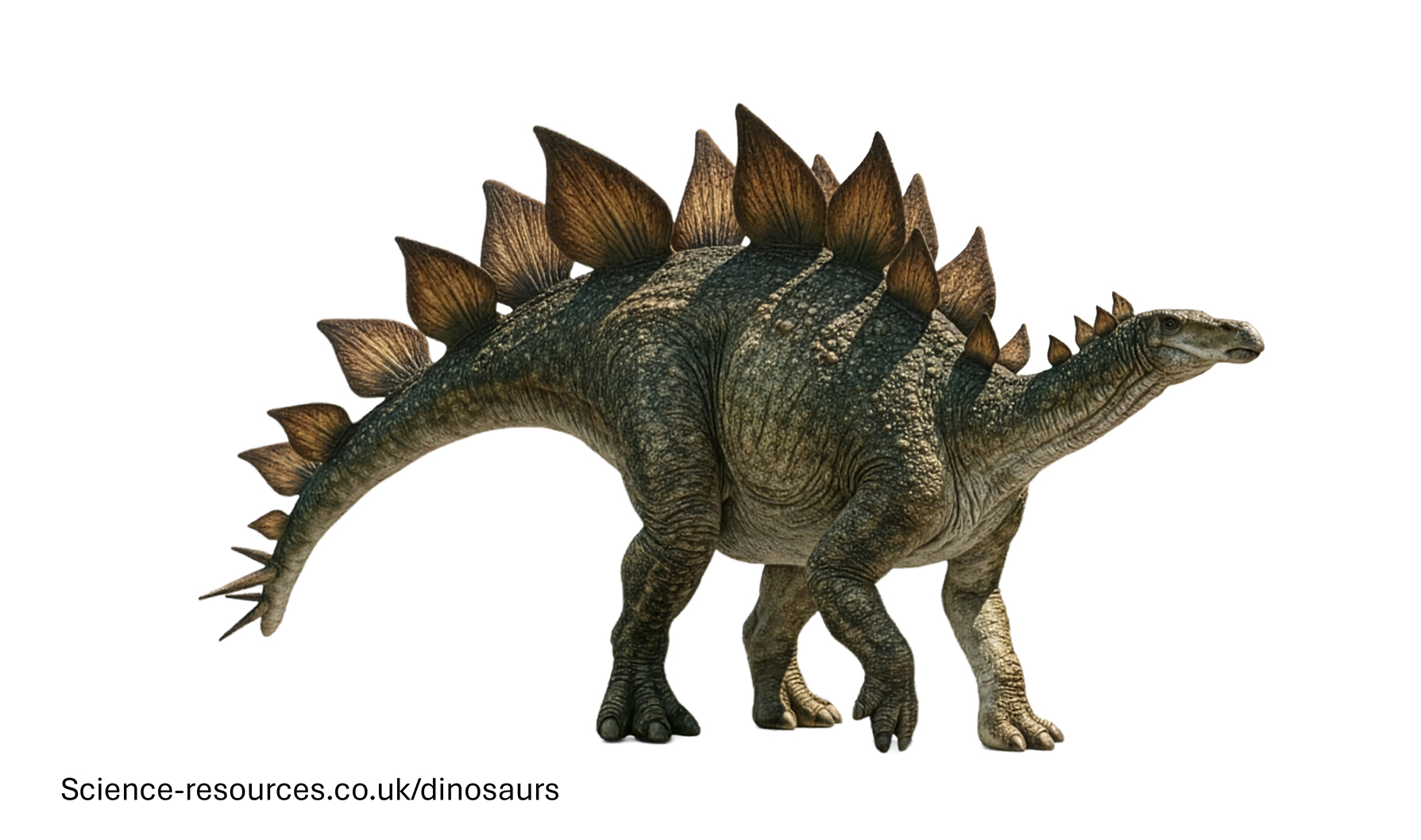Dinosaurs A:Z | S
You may also be intrested in: Free Dinosaur games
Dinosaurs: Stegosaurus (Roof Lizard)
You may also be intrested in: Free Dinosaur games
Last updated: 8th Feb 2025 Stegosaurus was a large, plant-eating dinosaur that lived during the late Jurassic period, about 145 million years ago. It is famous for its distinctive plates and spikes, and it lived in what is now Colorado, Utah, and Wyoming. Length: Stegosaurus could grow up to 26-30 feet (8-9 meters) long. Weight: They weighed around 7,000 pounds (3,200 kilograms), which is about the weight of a small car! Stegosaurus had a very distinct look with its two rows of large, kite-shaped plates running along its back and tail. These plates could reach up to 2 feet (0.6 meters) in height. Stegosaurus also had two pairs of long, sharp spikes at the end of its tail. These features made it look like a giant, armored lizard. Stegosaurus Generative AI Notification: Some elements of this image have been created or enhanced using AI technology. To find out how we create all our dinosaurs, click here. Stegosaurus was a herbivore, meaning it only ate plants. It had a beak-like mouth to help pluck plants and small, leaf-shaped teeth to chew them. Fossil remains of Stegosaurus have been found in North America, particularly in Colorado, Utah, and Wyoming. They lived alongside other famous dinosaurs like Allosaurus and Ceratosaurus. • Defense: Stegosaurus used its spiked tail, known as a "thagomizer," to defend itself from predators. A fossilized tailbone of an Allosaurus has a hole in it the size of a Stegosaurus spike! • Plates Mystery: The plates on Stegosaurus's back may have been used to attract mates, scare off predators, or regulate body temperature. Scientists are still unsure of their exact purpose. • Small Brain: Stegosaurus had a tiny brain, about the size of a walnut. Early scientists thought it had a second brain in its hip area, but this is now believed to have been a mass of nerves. • Family Groups: Fossil footprints suggest that Stegosaurus likely traveled in family groups or herds. What is a Stegosaurus?
How big was Stegosaurus?
Appearance

What did Stegosaurus eat?
Where did Stegosaurus live?
Interesting Facts
Pronounced: STEG-oh-SAW-rus


Stegosaurus Facts
Name Means: "Roof Lizard"
Length: 30 feet (9 m)
Height: 8 feet (2.7 m)
Weight: 2 tons (1,800 kg)
Diet: Herbivore (Low-lying
Plants)
Time: Late Jurassic - 155 million years ago
Habitat: Open
Woodland
Fossils Found: Africa, Asia, Western North America
Stegosaurus belonged to a group of dinosaurs called Stegosaurs. Other members of this group included Tuojiangosaurus, Lexovisaurus, and Kentrosaurus. Like all Stegosaurs, Stegosaurus had a small head, large plates, and spiked tails.
Q1: What is a Stegosaurus?
A1: Stegosaurus was a large, plant-eating dinosaur that lived during the Late Jurassic period, around 150 million years ago. It is known for its distinctive back plates and spiked tail.
Q2: How big was the Stegosaurus?
A2: Stegosaurus could grow up to 9 meters (30 feet) long and weigh around 5 metric tons (11,000 pounds).
Q3: What did Stegosaurus eat?
A3: Stegosaurus was a herbivore, meaning it ate plants. It likely fed on low-lying vegetation such as ferns, cycads, and conifers.
Q4: How did Stegosaurus protect itself from predators?
A4: Stegosaurus had large, bony plates along its back and a spiked tail, called a thagomizer, which it used to defend itself against predators like Allosaurus.
Q5: Where have Stegosaurus fossils been found?
A5: Fossils of Stegosaurus have been discovered in North America, particularly in the United States, in states like Colorado, Wyoming, and Utah.
Q6: What makes Stegosaurus unique among dinosaurs?
A6: Stegosaurus is unique because of its double row of large, bony plates along its back and its spiked tail. These features make it one of the most recognisable dinosaurs.
Q7: How do scientists learn about Stegosaurus?
A7: Scientists study fossils, including bones and sometimes skin impressions, to learn about Stegosaurus. They also use modern technology like CT scans to examine the fossils in detail.
Q8: Did Stegosaurus live alone or in groups?
A8: It's not entirely clear, but some evidence suggests that Stegosaurus may have lived in small groups or herds.
Q9: What new discoveries have been made about Stegosaurus?
A9: Recent discoveries include a nearly complete Stegosaurus skeleton named "Apex," which has provided new insights into how Stegosaurus grew and its metabolism.
Q10: Why is Stegosaurus important to study?
A10: Studying Stegosaurus helps scientists understand more about the diversity of life during the Jurassic period and how these amazing creatures adapted to their environments.
Which family of Dinosaurs did Stegosaurus belong to?
Stegosaurus FAQ
You may also be intrested in:
Tags: How big was stegosaurus, Stegosaurus size, where does stegosaurus rex live, how tall are stegosaurus, what does stegosaurus mean, stegosaurus, stegosaurus brain facts